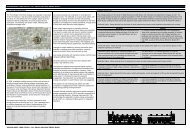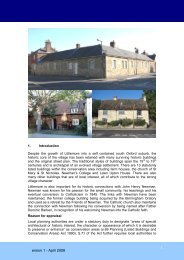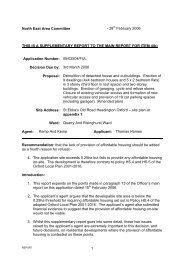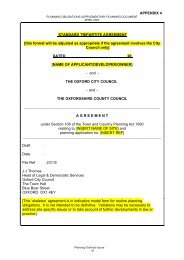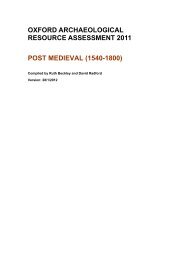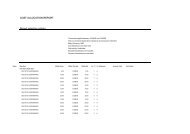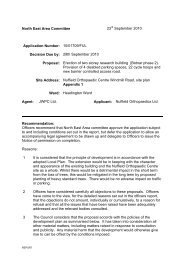Palaeolithic to Mesolithic Oxford (500000 - 4000 BC) - Oxford City ...
Palaeolithic to Mesolithic Oxford (500000 - 4000 BC) - Oxford City ...
Palaeolithic to Mesolithic Oxford (500000 - 4000 BC) - Oxford City ...
You also want an ePaper? Increase the reach of your titles
YUMPU automatically turns print PDFs into web optimized ePapers that Google loves.
Introduction<br />
This assessment report forms part of the resource assessment stage of the <strong>Oxford</strong><br />
Archaeological Plan for the district. The archaeological assessment aims <strong>to</strong> inform<br />
resource management in planning and development control as well as aid academic<br />
investigation and research. Throughout these reports the ‘city’ will refer <strong>to</strong> the area<br />
covered by the UAD while ‘LAA’ (Local Authority Area) will be used for sites beyond<br />
the his<strong>to</strong>ric centre.<br />
At a regional level available syntheses have been provided by the Solent Thames<br />
Research Frameworks for the Lower <strong>to</strong> Middle <strong>Palaeolithic</strong> (Wenban-Smith et al.<br />
2010) and the Late Upper <strong>Palaeolithic</strong> <strong>to</strong> the <strong>Mesolithic</strong> (Hey et al, 2010). At a county<br />
level, the most recent synthesis is the Solent Thames Research Frameworks<br />
covering the Lower <strong>to</strong> Middle <strong>Palaeolithic</strong> (Hardaker 2007) and the Late Upper<br />
<strong>Palaeolithic</strong> <strong>to</strong> the <strong>Mesolithic</strong> (Hey and Roberts 2008). A comprehensive overview of<br />
the <strong>Palaeolithic</strong> and <strong>Mesolithic</strong> of the Upper Thames has been published in the<br />
Thames Through Time Series (White, Schreve and Morrigi 2011). Previous notable<br />
papers have also been produced in for the Tom Hassall Lectures (Roe 1994; Barclay<br />
1996) and in 1986 (Roe; Case). In addition primary resources from the <strong>Oxford</strong>shire<br />
His<strong>to</strong>ric Environment Record (OHER) and the <strong>Oxford</strong> Urban Archaeological<br />
Database (UAD) have been consulted. Further publications by Roe (1968; 1981) and<br />
Wymer (1968; 1999; Wymer and Bonsall 1977) have also been consulted.<br />
The nature of the evidence base<br />
Unlike later periods the archaeological record for the <strong>Palaeolithic</strong> and <strong>Mesolithic</strong><br />
periods is largely comprised of lithic artefacts and related palaeo-environmental<br />
evidence. There are few, if any, structural remains and artefacts made of organic<br />
materials are extremely rare. The evidence for the Lower and Middle <strong>Palaeolithic</strong><br />
periods has largely been recovered from gravel extraction sites and the distribution is<br />
therefore biased <strong>to</strong>wards the gravel terraces. The number of Upper <strong>Palaeolithic</strong> and<br />
<strong>Mesolithic</strong> artefacts recorded from the district is likely <strong>to</strong> be under-represented at<br />
present as many lithic artefacts identified from museum archives or 19 th century<br />
recorded observation are recorded only as being ‘prehis<strong>to</strong>ric’ and the accompanying<br />
information is often limited.<br />
Key themes<br />
It is difficult based on the current evidence <strong>to</strong> identify any distinct phases of activity in<br />
the <strong>Palaeolithic</strong> and <strong>Mesolithic</strong> periods in the <strong>Oxford</strong> district however the following<br />
key points can be highlighted:<br />
The interglacial Wolvercote Channel Deposit (probably MIS 9) has produced<br />
what appears <strong>to</strong> be an in situ, or little disturbed, <strong>to</strong>ol manufacturing site. This<br />
is currently the oldest and most significant Lower <strong>Palaeolithic</strong> assemblage<br />
known from the district.<br />
Most Lower <strong>Palaeolithic</strong> material from the district consists of stray finds of<br />
rolled artefacts from the Summer<strong>to</strong>wn-Radley Gravel Formation (mainly MIS<br />
7-6). The only major assemblage of material comes from the Cornish’s Pit site<br />
in Iffley<br />
No British Mousterian material has yet been found in the district, and the<br />
reported possible Levallois flake from Davenant Road is probably of Lower<br />
<strong>Palaeolithic</strong> age (Wymer 1968).<br />
Until recently no Upper <strong>Palaeolithic</strong> artefacts were known from the district,<br />
however a few objects of this age were identified in museum collections<br />
OXFORD ARCHAEOLOGICAL RESOURCE ASSESSMENT- PALAEOLITHIC TO<br />
MESOLITHIC 3



